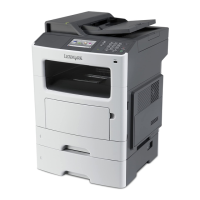Your print materials supplier should be able to help develop your application or solve a problem you have with an
existing application. In addition, Lexmark has worked with several suppliers and has business partners in this field. For
technical assistance contact numbers, see the printer registration card, information on the printer CD, or visit the
Lexmark Web site at
http://support.lexmark.com.
Design factors
Print materials all have measurable characteristics that you need to consider when selecting or designing forms for
your particular application.
Basis weight
Basis weight is a term used to describe the weight in pounds of 500 sheets of paper (one ream). However, the weight
is determined based on the standard size of the paper, which may not be the purchased size. For example, the standard
size of 20‑lb bond paper is 17 x 22 inches, and a ream of 17 x 22‑inch 20‑lb bond paper weighs 20 pounds. If the
17 x 22‑inch 20‑lb bond paper was cut, creating four reams of 8.5 x 11‑inch paper, each ream would be labeled 20‑lb
bond paper but would only weigh five pounds.
If the same paper weighed 24 pounds, it would be called 24‑lb bond. The 24‑lb bond paper is thicker, heavier, and more
dense than the 20‑lb bond. Thicker paper means less paper can be placed in a tray, and paper that is heavier and more
dense may cause paper jams or feed reliability problems in some printers. Check the supported paper weights table
located in the printer documentation to verify that the paper basis weight being used is acceptable.
Not all basis weights are related to the same standard sheet size: for example, 70‑lb material can be lighter than 40‑lb
material if it is based on larger base size paper. The metric measurement of grams per square meter (g/m
2
) is a more
consistent way to compare weights and has been standardized by the International Organization for Standardization
(ISO). For more information, locate your printer in the “Printer specifications” chapter.
Your printer can accept a wide range of stock weights, but materials either too light or too heavy can cause printing
problems. Heavy and/or thicker materials may not heat quickly enough in the fuser, resulting in poor print quality. They
may also feed less reliably or skew due to their weight or rigidity. Conversely, lighter materials can wrinkle and jam in
the printer due to low beam strength (stiffness).
Depending on the orientation of the stock as it feeds through the printer, you may need to request that heavier materials
be cut grain short or grain long to provide flexibility in paper path turns. For more precise recommendations, locate
your printer in the “Printer specifications” chapter.
Dimensions
All printers have print material dimension limitations. See the printer documentation that came with your printer for
details. You can sometimes redesign forms to overcome these limitations. For example, if you use forms that are shorter
than the minimum length supported by your printer, you may be able to link two forms together when printing multiple
forms. An optional Universally Adjustable Tray designed for the Optra S, Optra T, and Lexmark T printer families prints
on a range of paper sizes including A6 and 3 x 5‑inch index cards, 3 x 7‑inch punch cards, and 4 x 6‑inch postcards.
Environment
Lexmark printers meet or exceed all industry emission regulations and standards. Continuous printing on some papers
or other media may create fumes that are not a problem with occasional printing. Make sure your printer is located in
a well‑ventilated area.
Temperature and humidity can have a major impact on printing. Even small changes (such as from day to night) can
greatly affect feed reliability if the print material is just within the range of acceptability.
General information 9

